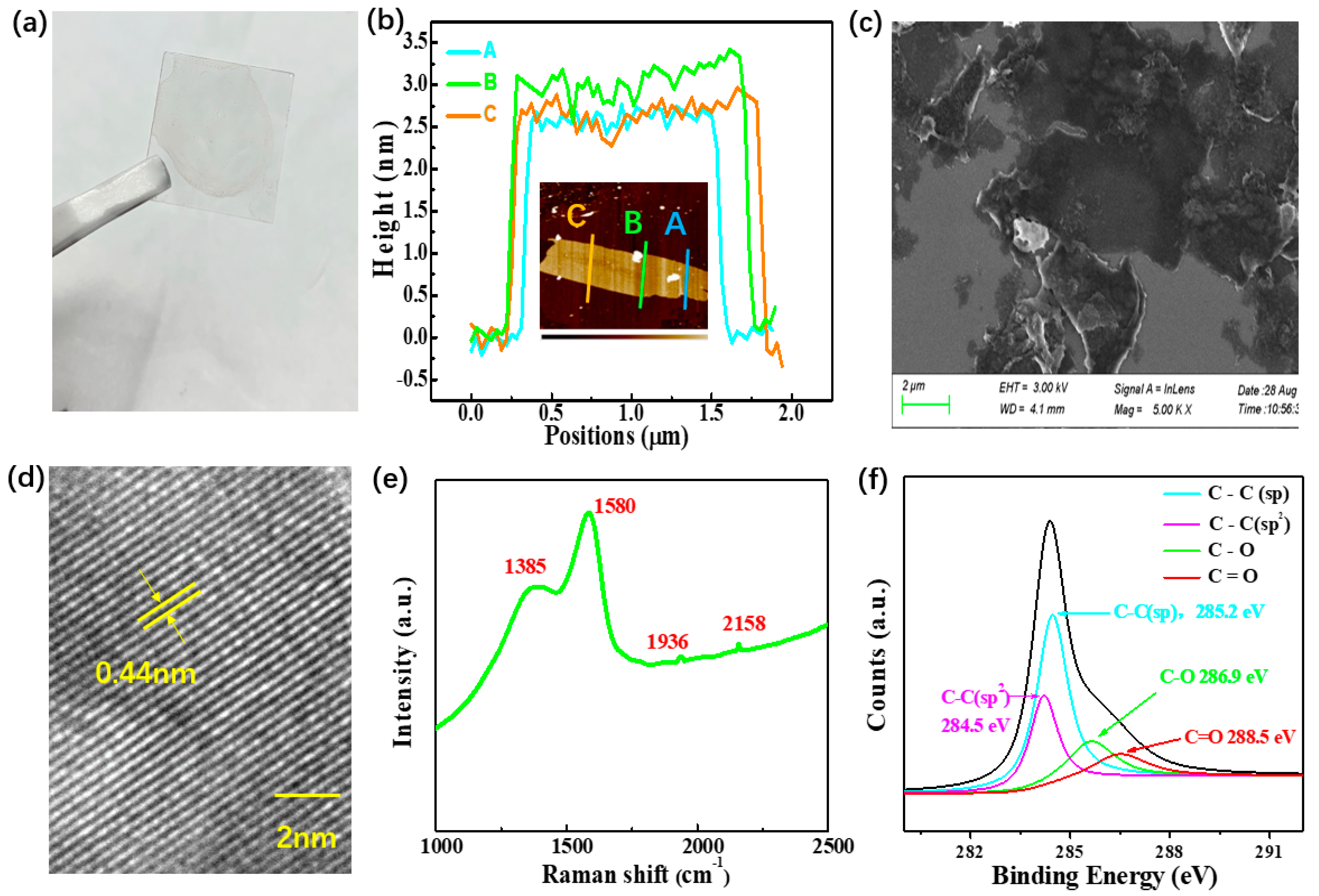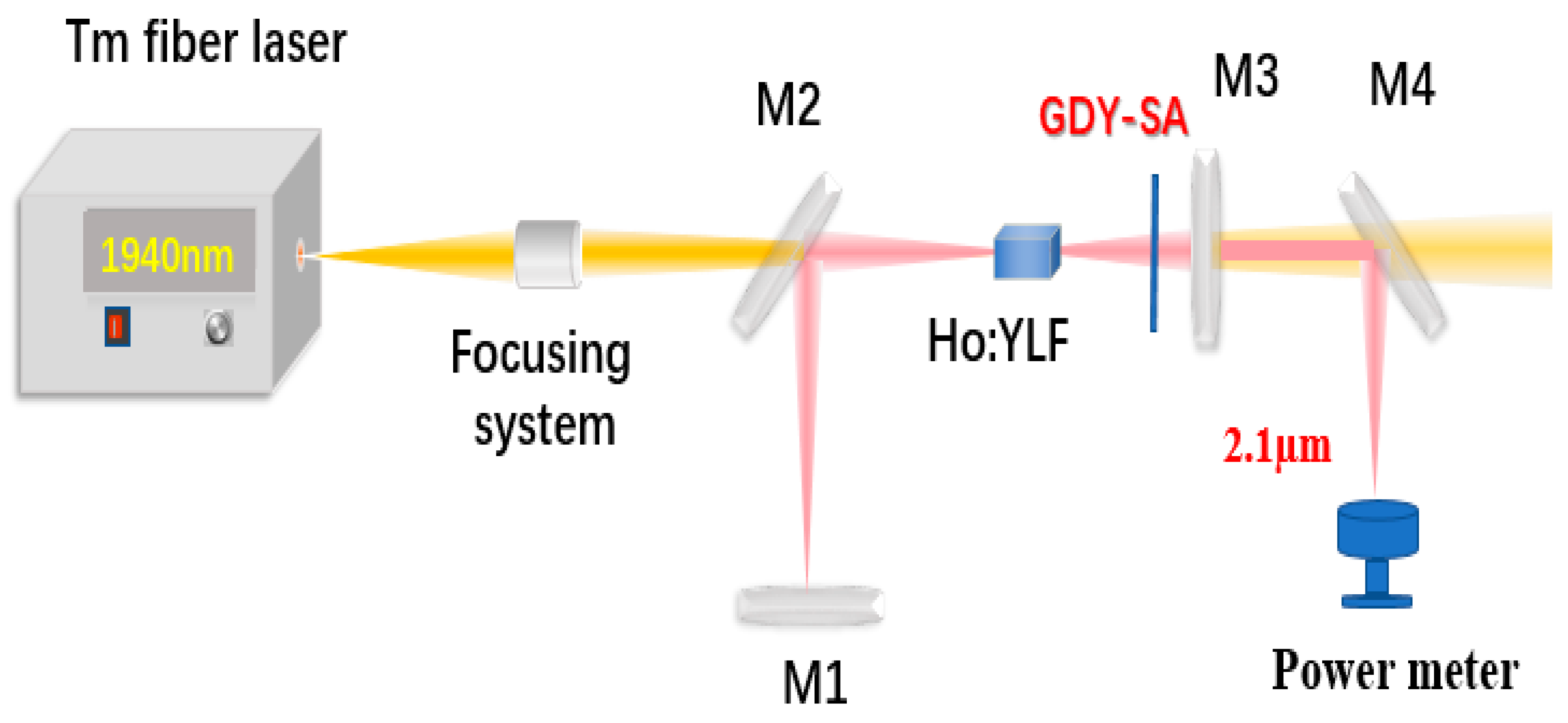Graphdiyne Saturable Absorber for Passively Q-Switched Ho3+-Doped Laser
Abstract
1. Introduction
2. Fabrication and Characteristics of GDY-SA
3. Experimental Setup
4. Results and Discussions
5. Conclusions
Author Contributions
Funding
Conflicts of Interest
References
- Haddon, R.C. Chemistry of the fullerenes: The manifestation of strain in a class of continuous aromatic molecules. Science 1993, 261, 1545–1550. [Google Scholar] [CrossRef]
- Allen, M.J.; Tung, V.C.; Kaner, R.B. Honeycomb carbon: A review of graphene. Chem. Rev. 2010, 110, 132–145. [Google Scholar] [CrossRef]
- Teng, D.; Wang, K.; Li, Z. Graphene-Coated Nanowire Waveguides and Their Applications. Nanomaterials 2020, 10, 229. [Google Scholar] [CrossRef]
- Novoselov, K.S.; Grigorieva, I.V.; Firsov, A.A. Electric field effect in atomically thin carbon films. Science 2004, 306, 666–669. [Google Scholar] [CrossRef]
- Baughman, R.H.; Eckhardt, H.; Kertesz, M. Structure-property predictions for new planar forms of carbon: Layered phases containing sp2 and sp atoms. J. Chem. Phys. 1987, 87, 6687–6699. [Google Scholar] [CrossRef]
- Zhang, Z.H.; Zhang, J.J.; Kwong, G.; Li, J.; Fan, Z.Q.; Deng, X.Q.; Tang, G.P. All-carbon sp-sp2 hybrid structures: Geometrical properties, current rectification, and current amplification. Sci. Rep. 2013, 3, 2575. [Google Scholar] [CrossRef]
- Wang, J.T.; Chen, C.F.; Li, H.D.; Mizuseki, H.; Kawazoe, Y. Three-dimensional carbon allotropes comprising phenyl rings and acetylenic chains in sp+sp2 hybrid networks. Sci. Rep. 2016, 6, 24665. [Google Scholar] [CrossRef]
- Baughman, R.H.; Zakhidov, A.A.; De Heer, W.A. Carbon nanotubes: The route toward applications. Science 2002, 297, 787–792. [Google Scholar] [CrossRef]
- Li, G.X.; Li, Y.L.; Liu, H.B.; Guo, Y.B.; Li, Y.J.; Zhu, D.B. Architecture of graphdiyne nanoscale films. Chem. Commun. 2010, 46, 3256–3258. [Google Scholar] [CrossRef]
- Huang, C.S.; Li, Y.J.; Wang, N.; Xue, Y.R.; Zuo, Z.C.; Liu, H.B.; Li, Y.L. Progress in Research into 2D Graphdiyne-Based Materials. Chem. Rev. 2018, 118, 7744–7803. [Google Scholar] [CrossRef]
- Jia, Z.; Li, Y.; Zuo, Z.; Liu, H.; Huang, C.; Li, Y. Synthesis and Properties of 2D Carbon-Graphdiyne. Acc. Chem. Res. 2017, 50, 2470–2478. [Google Scholar] [CrossRef] [PubMed]
- Huang, C.S.; Zhao, Y.L.; Li, Y.L. Graphdiyne: The Fundamentals and Application of an Emerging Carbon Material. Adv. Mater. 2019, 31, 1904885. [Google Scholar] [CrossRef]
- Lu, X.L.; Han, Y.Y.; Lu, T.B. Structure Characterization and Application of Graphdiyne in Photocatalytic and Electrocatalytic Reactions. Acta Phys. Chim. Sin. 2018, 34, 1014–1028. [Google Scholar] [CrossRef]
- Iijima, S. Helical microtubules of graphitic carbon. Nature 1991, 354, 56–58. [Google Scholar] [CrossRef]
- Chen, Y.H.; Liu, H.B.; Li, Y.L. Progress and prospect of two dimensional carbon graphdiyne. Chin. Sci. Bull. 2016, 61, 2901–2912. (In Chinese) [Google Scholar] [CrossRef]
- Cui, H.J.; Sheng, X.L.; Yan, Q.B.; Zheng, Q.R.; Su, G. Strain-induced Dirac cone-like electronic structures and semiconductor-semimetal transition in graphdiyne. Phys. Chem. Chem. Phys. 2013, 15, 8179–8185. [Google Scholar] [CrossRef]
- Li, Y.H.; Li, Y.L. Two Dimensional Polymers Progress of Full Carbon Graphyne. Acta Polym. Sin. 2015, 2, 147–165. [Google Scholar]
- Sun, L.; Jiang, P.H.; Liu, H.J.; Fan, D.D.; Liang, J.H.; Wei, J.; Cheng, L.; Zhang, J.; Shi, J. Graphdiyne: A two-dimensional thermoelectric material with high figure of merit. Carbon 2015, 90, 255–259. [Google Scholar] [CrossRef]
- Budni, P.A.; Ibach, C.R.; Setzler, S.D.; Gustafson, E.J.; Castro, R.T.; Chicklis, E.P. 50-mJ, Q-switched, 2.09-µm holmium laser resonantly pumped by a diode-pumped 1.9-µm thulium laser. Opt. Lett. 2003, 28, 1016–1018. [Google Scholar] [CrossRef]
- Yang, X.T.; He, Y.B.; Liu, X.N.; Jiang, Z.Y.; Chen, S.T.; Mu, Y.L.; Yang, L.L.; Zhang, Z.J.; Zhao, N.B. A passively Q-switched Ho:SSO laser with a Cr2+: ZnSe saturable absorber. Infrared Phys. Technol. 2019, 98, 121–124. [Google Scholar] [CrossRef]
- Caron, J.; Durand, Y. Operating wavelengths optimization for a spaceborne lidar measuring atmospheric CO2. Appl. Opt. 2009, 48, 5413–5422. [Google Scholar] [CrossRef] [PubMed]
- Coluccelli, N.; Lagatsky, A.; Lieto, A.D.; Tonelli, M.; Galzerano, G.; Sibbett, W.; Laporta, P. Passive mode locking of an in-band-pumped Ho:YLiF4 laser at 2.06 µm. Opt. Lett. 2011, 36, 3209–3211. [Google Scholar] [CrossRef] [PubMed]
- Zhang, C.; Zu, Y.Q.; Yang, W.; Jiang, S.Z.; Liu, J. Epsilon-near-zero medium for optical switches in Ho solid-state laser at 2.06 µm. Opt. Laser Technol. 2020, 129, 106271. [Google Scholar] [CrossRef]
- Duan, X.M.; Shen, Y.J.; Zhang, Z.; Su, L.B.; Dai, T.Y. A passively Q-switching of diode-pumped 2.08-µm Ho:CaF2 laser. Infrared Phys. Technol. 2019, 103, 103071. [Google Scholar] [CrossRef]
- Liu, J.J.; Huang, H.; Zhang, F.; Zhang, Z.; Liu, J.; Zhang, H.; Su, L.B. Bismuth nanosheets as a Q-switcher for a mid-infrared erbium-doped SrF2 laser. Photonics Res. 2018, 6, 762–767. [Google Scholar] [CrossRef]
- Guo, Q.X.; Pan, J.; Li, D.W.; Shen, Y.M.; Han, X.L.; Gao, J.J.; Man, B.Y.; Zhang, H.N.; Jiang, S.Z. Versatile Mode-Locked Operations in an Er-Doped Fiber Laser with a Film-Type Indium Tin Oxide Saturable Absorber. Nanomaterials 2019, 9, 701. [Google Scholar] [CrossRef]
- Ge, P.G.; Liu, J.; Jiang, S.Z.; Xu, Y.Y.; Man, B.Y. Compact Q-switched 2 µm Tm:GdVO4 laser with MoS2 absorber. Photonics Res. 2015, 3, 256–259. [Google Scholar] [CrossRef]
- Li, Z.Q.; Li, R.; Pang, C.; Dong, N.N.; Wang, J.; Yu, H.H.; Chen, F. 8.8 GHz Q-switched mode-locked waveguide lasers modulated by PtSe2 saturable absorber. Opt. Express 2019, 27, 8727–8737. [Google Scholar] [CrossRef]
- Zong, M.Y.; Yang, X.J.; Liu, J.J.; Zhang, Z.; Jiang, S.Z.; Liu, J.; Su, L.B. Er:CaF2 single-crystal fiber Q-switched laser with diode pumping in the mid-infrared region. J. Lumin. 2020, 227, 117519. [Google Scholar] [CrossRef]
- Zhao, M.F.; Zhang, Z.M.; Feng, X.Y.; Zong, M.Y.; Liu, J.; Xu, X.D.; Zhang, H. High repetition rate passively Q-switched laser on Nd:SRA at 1049 nm with MXene Ti3C2Tx. Chin. Opt. Lett. 2020, 18, 041401. [Google Scholar] [CrossRef]
- Li, Z.Q.; Zhang, Y.X.; Cheng, C.; Yu, H.H.; Chen, F. 6.5 GHz Q-switched mode-locked waveguide lasers based on two-dimensional materials as saturable absorbers. Opt. Express 2018, 26, 11321–11330. [Google Scholar] [CrossRef] [PubMed]
- Zu, Y.Q.; Zhang, C.; Guo, X.S.; Liang, W.Y.; Liu, J.; Su, L.B.; Zhang, H. A solid-state passively Q-switched Tm, Gd:CaF2 laser with a Ti3C2Tx MXene absorber near 2 µm. Laser Phys. Lett. 2019, 16, 015803. [Google Scholar] [CrossRef]
- Feng, X.Y.; Liu, J.J.; Yang, W.; Yu, X.R.; Jiang, S.Z.; Ning, T.Y.; Liu, J. Broadband indium tin oxide nanowire arrays as saturable absorbers for solid-state lasers. Opt. Express 2020, 28, 1554–1560. [Google Scholar] [CrossRef] [PubMed]
- Zhao, X.; Zheng, Z.; Liu, L.; Liu, Y.; Jiang, Y.; Yang, X.; Zhu, J. Switchable, dual-wavelength passively mode-locked ultrafast fiber laser based on a single-wall carbon nanotube modelocker and intracavity loss tuning. Opt. Express 2011, 19, 1168–1173. [Google Scholar] [CrossRef]
- Bonaccorso, F.; Sun, Z.; Hasan, T.; Ferrari, A.C. Graphene photonics and optoelectronics. Nat. Photonics 2010, 4, 611–622. [Google Scholar] [CrossRef]
- Lee, D.; Park, K.; Debnath, P.C.; Kim, I.; Song, Y.W. Thermal damage suppression of a black phosphorus saturable absorber for high-power operation of pulsed fiber. Lasers Nanotechnol. 2016, 27, 365203. [Google Scholar] [CrossRef]
- Guo, J.; Shi, R.C.; Wang, R.; Wang, Y.Z.; Zhang, F.; Wang, C.; Chen, H.L.; Ma, C.Y.; Wang, Z.H.; Ge, Y.Q.; et al. Graphdiyne-Polymer Nanocomposite as a Broadband and Robust Saturable Absorber for Ultrafast Photonics. Laser Photonics Rev. 2020, 14, 1900367. [Google Scholar] [CrossRef]
- Guo, J.; Wang, Z.H.; Shi, R.C.; Zhang, Y.; He, Z.W.; Gao, L.F.; Wang, R.; Shu, Y.Q.; Ma, C.Y.; Ge, Y.Q.; et al. Graphdiyne as a Promising Mid-Infrared Nonlinear Optical Material for Ultrafast Photonics. Adv. Opt. Mater. 2020, 8, 2000067. [Google Scholar] [CrossRef]
- Zu, Y.Q.; Guo, J.; Hao, Q.Q.; Zhang, F.; Wang, C.; Liu, J.; Zhang, H. Graphdiyne as a saturable absorber for 2-µm all solid-state Q-switched laser. Sci. China Mater. 2020. [Google Scholar] [CrossRef]
- Matsuoka, R.; Sakamoto, R.; Hoshiko, K.; Sasaki, S.; Masunaga, H.; Nagashio, K.; Nishihara, H. Crystalline Graphdiyne Nanosheets Produced at a Gas/Liquid or Liquid/Liquid Interface. J. Am. Chem. Soc. 2017, 139, 3145–3152. [Google Scholar] [CrossRef]
- Chen, Y.; Zhao, C.; Huang, H.; Chen, S.; Tang, P.; Wang, Z.; Lu, S.; Zhang, H.; Wen, S.; Tang, D. Self-assembled topological insulator-Bi2Se3 membrane as a passive Q-switcher in an erbium-doped fiber laser. J. Lightwave Technol. 2013, 31, 2857–2863. [Google Scholar] [CrossRef]








| Transmittance of the OC | T = 1% | T = 3% |
|---|---|---|
| Shortest pulse width/µs | 1.54 | 1.38 |
| Repetition rate/kHz | 25.02 | 29.72 |
| Peak power/W | 9.08 | 10.8 |
| Single pulse energy/µJ | 13.99 | 14.91 |
© 2020 by the authors. Licensee MDPI, Basel, Switzerland. This article is an open access article distributed under the terms and conditions of the Creative Commons Attribution (CC BY) license (http://creativecommons.org/licenses/by/4.0/).
Share and Cite
Zhang, C.; Hao, Q.; Zu, Y.; Zong, M.; Guo, J.; Zhang, F.; Ge, Y.; Liu, J. Graphdiyne Saturable Absorber for Passively Q-Switched Ho3+-Doped Laser. Nanomaterials 2020, 10, 1848. https://doi.org/10.3390/nano10091848
Zhang C, Hao Q, Zu Y, Zong M, Guo J, Zhang F, Ge Y, Liu J. Graphdiyne Saturable Absorber for Passively Q-Switched Ho3+-Doped Laser. Nanomaterials. 2020; 10(9):1848. https://doi.org/10.3390/nano10091848
Chicago/Turabian StyleZhang, Cheng, Qianqian Hao, Yuqian Zu, Mengyu Zong, Jia Guo, Feng Zhang, Yanqi Ge, and Jie Liu. 2020. "Graphdiyne Saturable Absorber for Passively Q-Switched Ho3+-Doped Laser" Nanomaterials 10, no. 9: 1848. https://doi.org/10.3390/nano10091848
APA StyleZhang, C., Hao, Q., Zu, Y., Zong, M., Guo, J., Zhang, F., Ge, Y., & Liu, J. (2020). Graphdiyne Saturable Absorber for Passively Q-Switched Ho3+-Doped Laser. Nanomaterials, 10(9), 1848. https://doi.org/10.3390/nano10091848





